Fuse Peugeot 207 CC 2012 Owner's Manual
[x] Cancel search | Manufacturer: PEUGEOT, Model Year: 2012, Model line: 207 CC, Model: Peugeot 207 CC 2012Pages: 224, PDF Size: 7.1 MB
Page 5 of 224
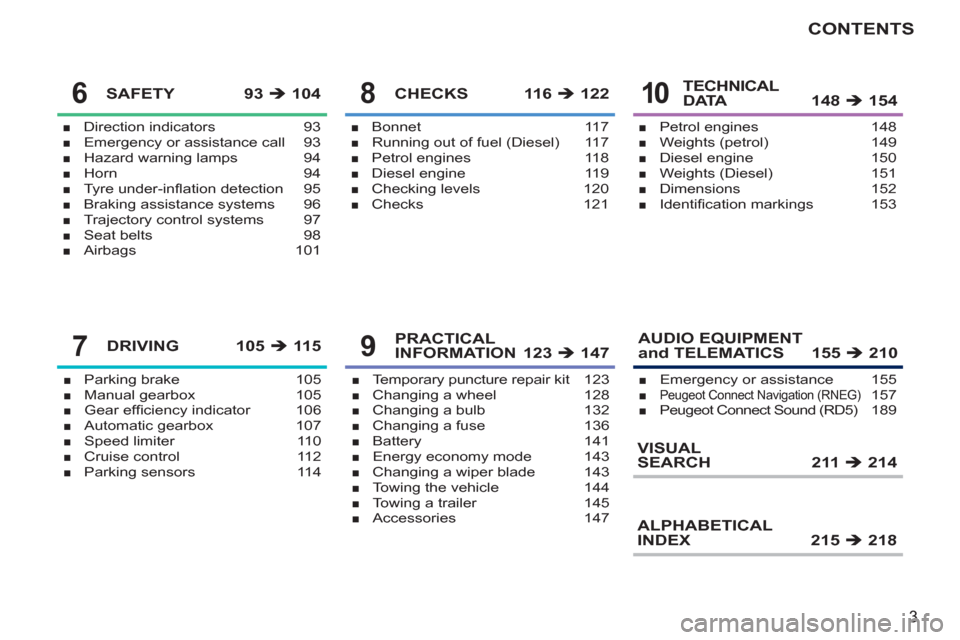
3
CONTENTS
Direction indicators 93
Emergency or assistance call 93
Hazard warning lamps 94
Horn 94
Tyre under-infl ation detection 95
Braking assistance systems 96
Trajectory control systems 97
Seat belts 98
Airbags 101■
■
■
■
■
■
■
■
■
SAFETY 93 �Π104
Parking brake 105
Manual gearbox 105
Gear effi ciency indicator 106
Automatic gearbox 107
Speed limiter 110
Cruise control 112
Parking sensors 114■
■
■
■
■
■
■
DRIVING 105 �Π11 5
Bonnet 117
Running out of fuel (Diesel) 117
Petrol engines 118
Diesel engine 119
Checking levels 120
Checks 121■
■
■
■
■
■
CHECKS 116 �Π122
Temporary puncture repair kit 123
Changing a wheel 128
Changing a bulb 132
Changing a fuse 136
Battery 141
Energy economy mode 143
Changing a wiper blade 143
Towing the vehicle 144
Towing a trailer 145
Accessories 147■
■
■
■
■
■
■
■
■
■
PRACTICAL
INFORMATION 123 �Π147
Petrol engines 148
Weights (petrol) 149
Diesel engine 150
Weights (Diesel) 151
Dimensions 152
Identifi cation markings 153■
■
■
■
■
■
TECHNICAL
D ATA 148 �Π154
AUDIO EQUIPMENT
and TELEMATICS 155 �Π210
Emergency or assistance 155Peugeot Connect Navigation (RNEG) 157
Peugeot Connect Sound (RD5) 189■
■
■
ALPHABETICAL
INDEX 215 �Π218
7
86
9
10
VISUAL
SEARCH 211 �Π214
Page 8 of 224
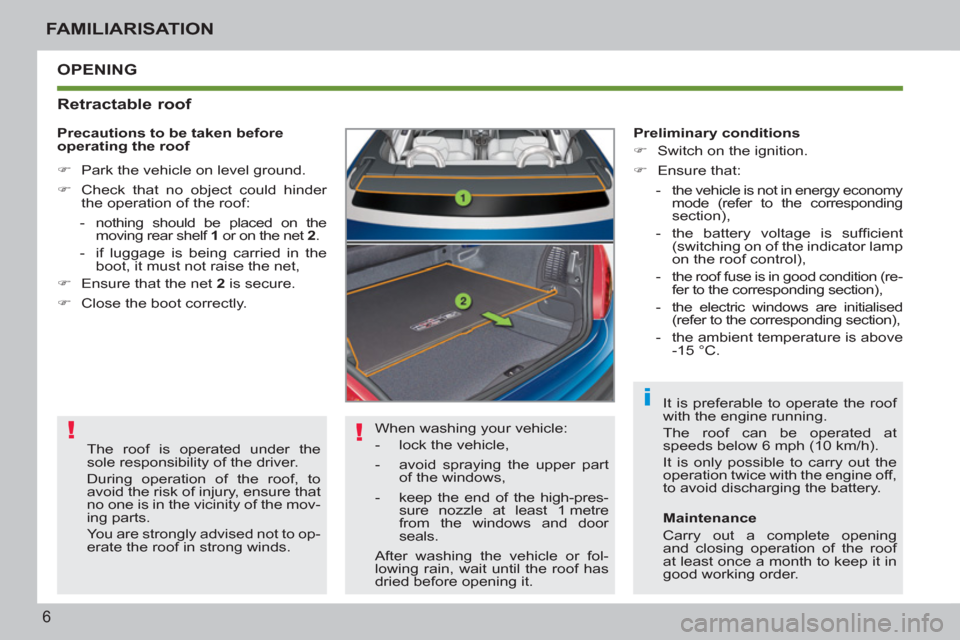
! !
i
6
FAMILIARISATION
OPENING
Retractable roof
When washing your vehicle:
- lock the vehicle,
- avoid spraying the upper part
of the windows,
- keep the end of the high-pres-
sure nozzle at least 1 metre
from the windows and door
seals.
After washing the vehicle or fol-
lowing rain, wait until the roof has
dried before opening it. The roof is operated under the
sole responsibility of the driver.
During operation of the roof, to
avoid the risk of injury, ensure that
no one is in the vicinity of the mov-
ing parts.
You are strongly advised not to op-
erate the roof in strong winds. It is preferable to operate the roof
with the engine running.
The roof can be operated at
speeds below 6 mph (10 km/h).
It is only possible to carry out the
operation twice with the engine off,
to avoid discharging the battery.
Preliminary conditions
�)
Switch on the ignition.
�)
Ensure that:
- the vehicle is not in energy economy
mode (refer to the corresponding
section),
- the battery voltage is suffi cient
(switching on of the indicator lamp
on the roof control),
- the roof fuse is in good condition (re-
fer to the corresponding section),
- the electric windows are initialised
(refer to the corresponding section),
- the ambient temperature is above
-15 °C.
Precautions to be taken before
operating the roof
�)
Park the vehicle on level ground.
�)
Check that no object could hinder
the operation of the roof:
- nothing should be placed on the
moving rear shelf 1
or on the net 2
.
- if luggage is being carried in the
boot, it must not raise the net,
�)
Ensure that the net 2
is secure.
�)
Close the boot correctly.
Maintenance
Carry out a complete opening
and closing operation of the roof
at least once a month to keep it in
good working order.
Page 11 of 224
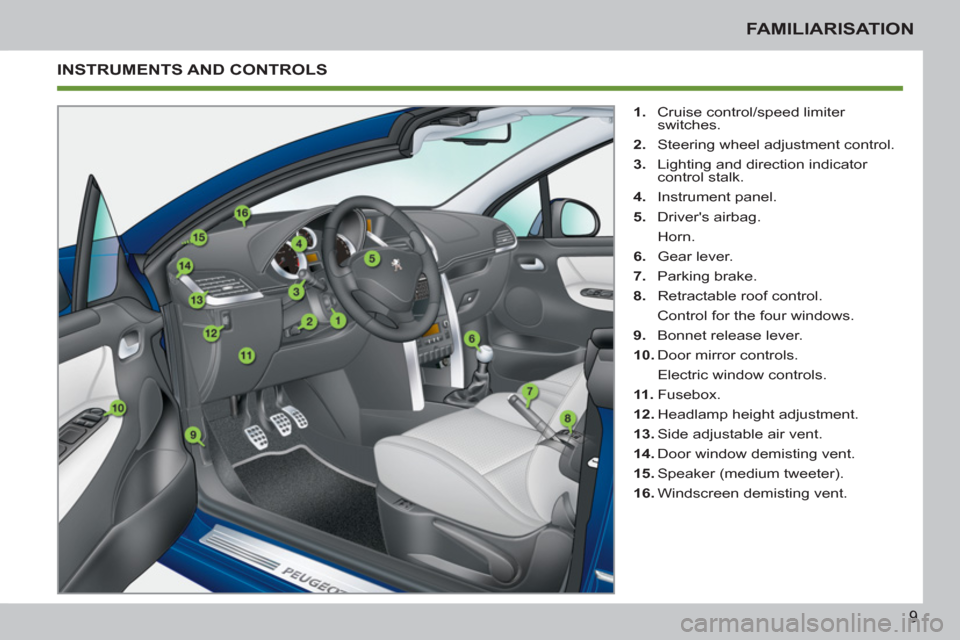
9
FAMILIARISATION
INSTRUMENTS AND CONTROLS
1.
Cruise control/speed limiter
switches.
2.
Steering wheel adjustment control.
3.
Lighting and direction indicator
control stalk.
4.
Instrument panel.
5.
Driver's airbag.
Horn.
6.
Gear lever.
7.
Parking brake.
8.
Retractable roof control.
Control for the four windows.
9.
Bonnet release lever.
10.
Door mirror controls.
Electric window controls.
11 .
Fusebox.
12.
Headlamp height adjustment.
13.
Side adjustable air vent.
14.
Door window demisting vent.
15.
Speaker (medium tweeter).
16.
Windscreen demisting vent.
Page 47 of 224
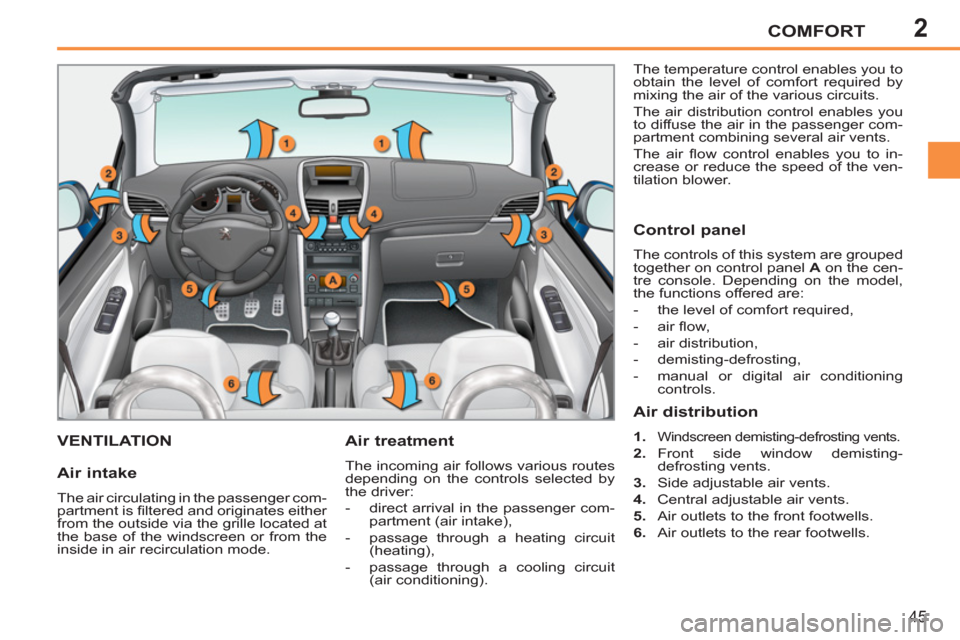
2COMFORT
45
VENTILATION
Air treatment
The incoming air follows various routes
depending on the controls selected by
the driver:
- direct arrival in the passenger com-
partment (air intake),
- passage through a heating circuit
(heating),
- passage through a cooling circuit
(air conditioning). The temperature control enables you to
obtain the level of comfort required by
mixing the air of the various circuits.
The air distribution control enables you
to diffuse the air in the passenger com-
partment combining several air vents.
The air fl ow control enables you to in-
crease or reduce the speed of the ven-
tilation blower.
Air intake
The air circulating in the passenger com-
partment is fi ltered and originates either
from the outside via the grille located at
the base of the windscreen or from the
inside in air recirculation mode.
Control panel
The controls of this system are grouped
together on control panel A
on the cen-
tre console. Depending on the model,
the functions offered are:
- the level of comfort required,
- air fl ow,
- air distribution,
- demisting-defrosting,
- manual or digital air conditioning
controls.
Air distribution
1.
Windscreen demisting-defrosting vents.
2.
Front side window demisting-
defrosting vents.
3.
Side adjustable air vents.
4.
Central adjustable air vents.
5.
Air outlets to the front footwells.
6.
Air outlets to the rear footwells.
Page 120 of 224

8CHECKS
118
PETROL ENGINES
The caps and covers provide access for checking the levels of the various fl uids and to replace certain components.
1.
Coolant reservoir.
2.
Passenger compartment fi lter.
3.
Screenwash and headlamp wash
reservoir.
4.
Air fi lter.
5.
Brake fl uid reservoir.
6.
Fusebox.
7.
Battery.
8.
Engine oil dipstick.
9.
Engine oil fi ller cap.
Page 121 of 224
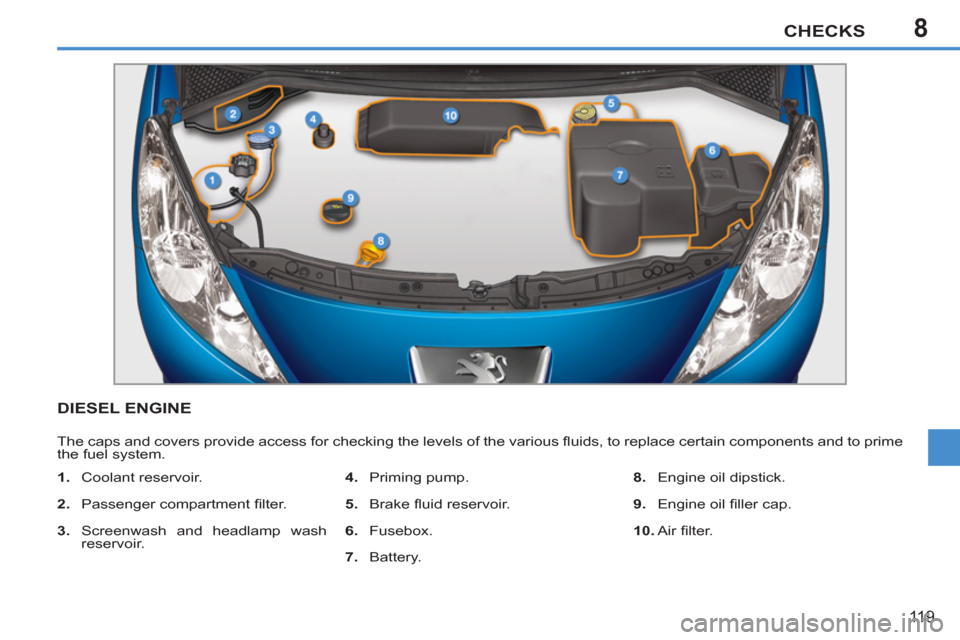
8CHECKS
119
DIESEL ENGINE
The caps and covers provide access for checking the levels of the various fl uids, to replace certain components and to prime
the fuel system.
1.
Coolant reservoir.
2.
Passenger compartment fi lter.
3.
Screenwash and headlamp wash
reservoir.
4.
Priming pump.
5.
Brake fl uid reservoir.
6.
Fusebox.
7.
Battery.
8.
Engine oil dipstick.
9.
Engine oil fi ller cap.
10.
Air fi lter.
Page 138 of 224
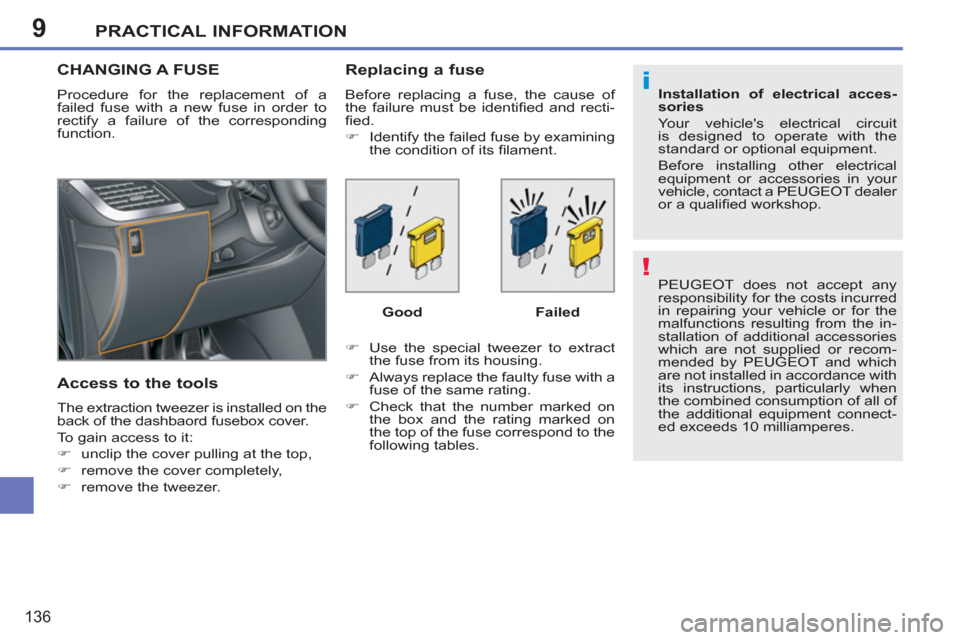
9
!
i
PRACTICAL INFORMATION
136
PEUGEOT does not accept any
responsibility for the costs incurred
in repairing your vehicle or for the
malfunctions resulting from the in-
stallation of additional accessories
which are not supplied or recom-
mended by PEUGEOT and which
are not installed in accordance with
its instructions, particularly when
the combined consumption of all of
the additional equipment connect-
ed exceeds 10 milliamperes.
Installation of electrical acces-
sories
Your vehicle's electrical circuit
is designed to operate with the
standard or optional equipment.
Before installing other electrical
equipment or accessories in your
vehicle, contact a PEUGEOT dealer
or a qualifi ed workshop.
CHANGING A FUSE
Procedure for the replacement of a
failed fuse with a new fuse in order to
rectify a failure of the corresponding
function.
Access to the tools
The extraction tweezer is installed on the
back of the dashbaord fusebox cover.
To gain access to it:
�)
unclip the cover pulling at the top,
�)
remove the cover completely,
�)
remove the tweezer.
Replacing a fuse
Before replacing a fuse, the cause of
the failure must be identifi ed and recti-
fi ed.
�)
Identify the failed fuse by examining
the condition of its fi lament.
�)
Use the special tweezer to extract
the fuse from its housing.
�)
Always replace the faulty fuse with a
fuse of the same rating.
�)
Check that the number marked on
the box and the rating marked on
the top of the fuse correspond to the
following tables.
Good
Failed
Page 139 of 224

9PRACTICAL INFORMATION
137
Dashboard fuses
The fusebox is placed in the lower dash-
board (left-hand side).
Access to the fuses
�)
refer to the "Access to the tools"
paragraph.
Fuse table
Fuse N°
Rating
Functions
G37
30 A
Retractable roof unit supply.
G38
20 A
Hi-Fi amplifi er.
G39
20 A
Driver and passenger heated seats.
G40
40 A
Trailer fusebox supply.
Fuse N°
Rating
Functions
F1
- Not used.
F2
- Not used.
F3
5 A
Airbags and pre-tensioners control unit.
F4
10 A
Clutch pedal switch, diagnostic socket,
electrochromatic rear view mirror, air conditioning,
steering wheel angle sensor, particle emission fi lter
pump (Diesel).
F5
30 A
Rear electric windows, retractable roof.
F6
30 A
Front electric windows, folding mirrors supply.
F7
5 A
Front courtesy lamp, map reading reading lamps,
sun visor lighting, glove box lighting.
Page 140 of 224
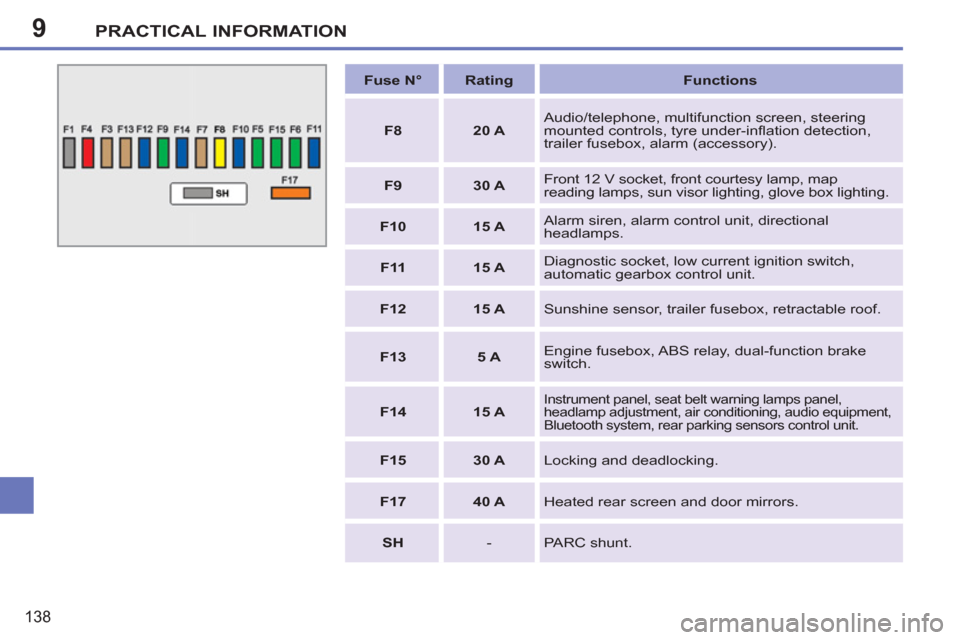
9PRACTICAL INFORMATION
138
Fuse N°
Rating
Functions
F8
20 A
Audio/telephone, multifunction screen, steering
mounted controls, tyre under-infl ation detection,
trailer fusebox, alarm (accessory).
F9
30 A
Front 12 V socket, front courtesy lamp, map
reading lamps, sun visor lighting, glove box lighting.
F10
15 A
Alarm siren, alarm control unit, directional
headlamps.
F11
15 A
Diagnostic socket, low current ignition switch,
automatic gearbox control unit.
F12
15 A
Sunshine sensor, trailer fusebox, retractable roof.
F13
5 A
Engine fusebox, ABS relay, dual-function brake
switch.
F14
15 A
Instrument panel, seat belt warning lamps panel,
headlamp adjustment, air conditioning, audio equipment,
Bluetooth system, rear parking sensors control unit.
F15
30 A
Locking and deadlocking.
F17
40 A
Heated rear screen and door mirrors.
SH
- PARC shunt.
Page 141 of 224
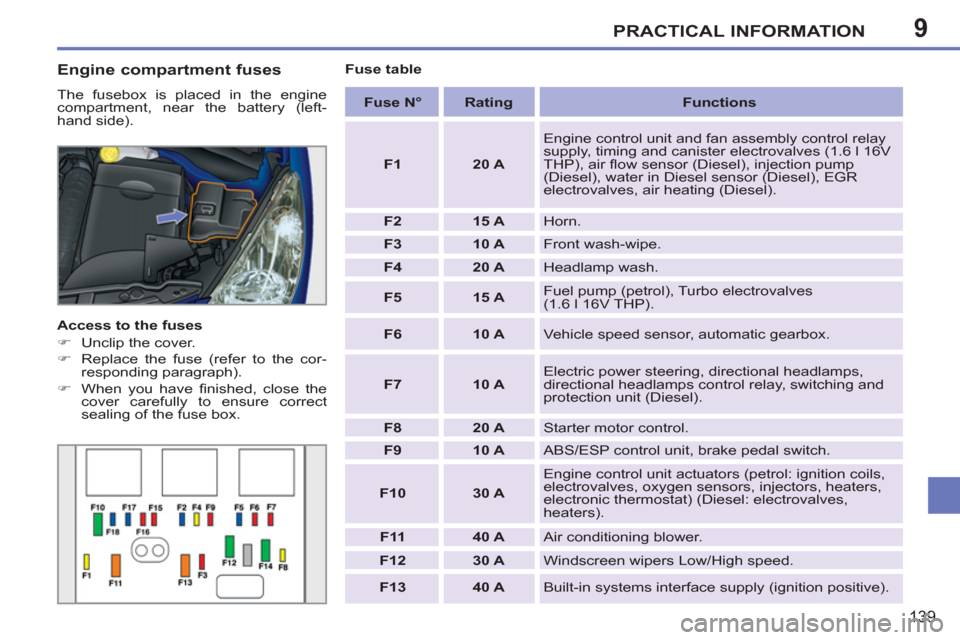
9PRACTICAL INFORMATION
139
Engine compartment fuses
The fusebox is placed in the engine
compartment, near the battery (left-
hand side).
Access to the fuses
�)
Unclip the cover.
�)
Replace the fuse (refer to the cor-
responding paragraph).
�)
When you have fi nished, close the
cover carefully to ensure correct
sealing of the fuse box.
Fuse table
Fuse N°
Rating
Functions
F1
20 A
Engine control unit and fan assembly control relay
supply, timing and canister electrovalves (1.6 l 16V
THP), air fl ow sensor (Diesel), injection pump
(Diesel), water in Diesel sensor (Diesel), EGR
electrovalves, air heating (Diesel).
F2
15 A
Horn.
F3
10 A
Front wash-wipe.
F4
20 A
Headlamp wash.
F5
15 A
Fuel pump (petrol), Turbo electrovalves
(1.6 l 16V THP).
F6
10 A
Vehicle speed sensor, automatic gearbox.
F7
10 A
Electric power steering, directional headlamps,
directional headlamps control relay, switching and
protection unit (Diesel).
F8
20 A
Starter motor control.
F9
10 A
ABS/ESP control unit, brake pedal switch.
F10
30 A
Engine control unit actuators (petrol: ignition coils,
electrovalves, oxygen sensors, injectors, heaters,
electronic thermostat) (Diesel: electrovalves,
heaters).
F11
40 A
Air conditioning blower.
F12
30 A
Windscreen wipers Low/High speed.
F13
40 A
Built-in systems interface supply (ignition positive).